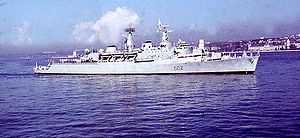HMS Devonshire (D02)
 HMS Devonshire after explosion, September 1976 | |
| Career (United Kingdom) | |
|---|---|
| Name: | HMS Devonshire |
| Ordered: | 24 January 1956 |
| Builder: | Cammell Laird |
| Laid down: | 9 March 1959 |
| Launched: | 10 June 1960 |
| Commissioned: | 15 November 1962 |
| Decommissioned: | 1978 |
| Identification: | Pennant number: D02 |
| Fate: | Sunk as a target on 17 July 1984 |
| General characteristics | |
| Class and type: | County-class destroyer |
| Displacement: | 5,440 tonnes (6,850 tonnes full load) |
| Length: | 158.6 m (520 ft 4 in) |
| Beam: | 53 ft (16 m) |
| Draught: | 20 ft (6.1 m) |
| Propulsion: | COSAG (Combined steam and gas) turbines, 2 shafts |
| Speed: | 31.5 knots (58.3 km/h) |
| Range: | 3,500 nautical miles (6,500 km) |
| Complement: | 470 |
| Armament: | 1× Sea Slug GWS.2 twin-arm SAM launcher(36 missiles) 2× Sea Cat GWS.21 twin-arm SAM launcher(60 missiles) 4× 4.5 in (114 mm) /45 DP (2× twin gunned turret) 2× 20 mm AA 2× triple-tubes for 12¾ inch (324 mm) ASW torpedo |
| Aircraft carried: | 1× Lynx or Wessex helicopter |
| Aviation facilities: | Flight deck and enclosed hangar for embarking one helicopter |
HMS Devonshire was the first of the County-class destroyers and the first Batch 1 ship of the Royal Navy. The ship was built by Cammell Laird in Birkenhead near Liverpool. With a displacement of 5,440 tonnes (6,850 tonnes full load), Devonshire was named after the English county of Devon. She was launched on 10 June 1960 and delivered to the navy two years later.
Operational Service
In 1962 Devonshire was commissioned and became the first operational Royal Navy ship to fire the Sea Slug missile.[1] Following work up, she sailed for the Mediterranean, followed by a return to her home port of Portsmouth. From here she then sailed for Bermuda and the United States.[2] She returned to Portsmouth just before the end of 1962.
She was involved in patrol duties in the Persian Gulf and the Caribbean Sea, but was not involved in any armed conflict of the United Kingdom. Like the other first batch of County-class ships, Devonshire was fitted with the Sea Slug anti aircraft missile defence system. She attended the 1977 Silver Jubilee Fleet Review off Spithead when she was part of the First Flotilla.[3]
Decommissioning and disposal
Devonshire was decommissioned under defence cuts in 1978, though was immediately offered for sale to Egypt, but the sale did not go through. Laid up in Portsmouth harbour for six years, the ship was used as a target, first for testing the new Sea Eagle air-launched cruise missile, then sunk by HMS Splendid as a target on 17 July 1984 (two days after the Sea Eagle test) in the North Atlantic, whilst testing the Mark 24-Mod-2 Tigerfish torpedo.
Commanding Officers
| From | To | Captain[4] |
|---|---|---|
| 1962 | 1964 | Captain P N Howes DSC RN |
| 1965 | 1965 | Captain D Williams RN |
| 1965 | 1966 | Captain G C Leslie OBE RN |
| 1966 | 1968 | Captain R K N Emden RN |
| 1970 | 1973 | Captain Sefton Sanford RN |
| 1975 | 1975 | Captain S A Stuart RN |
| 1976 | 1977 | Captain Skinner RN |
| 1977 | 1978 | Captain C A F Buchanan RN |
References
- ↑ http://www.naval-history.net/xGM-Ops-Events1961-70.htm
- ↑ Commissioning Book, HMS Devonshire 1962-1964, HMSO
- ↑ Official Souvenir Programme, 1977. Silver Jubilee Fleet Review, HMSO
- ↑ http://royalnavymemories.co.uk/hms-devonshires-captains/
Publications
- Colledge, J. J.; Warlow, Ben (2006) [1969]. Ships of the Royal Navy: The Complete Record of all Fighting Ships of the Royal Navy (Rev. ed.). London: Chatham Publishing. ISBN 978-1-86176-281-8. OCLC 67375475.
- Marriot, Leo,Royal Navy Destroyers since 1945, Ian Allan, ISBN 0-7110-1817-0
External links
See also
- List of ship launches in 1960
- List of ship commissionings in 1962
- List of ship decommissionings in 1978
- List of shipwrecks in 1984
| ||||||||||||||||||||||
Her name was also used in the James bond film Tomorrow Never Dies